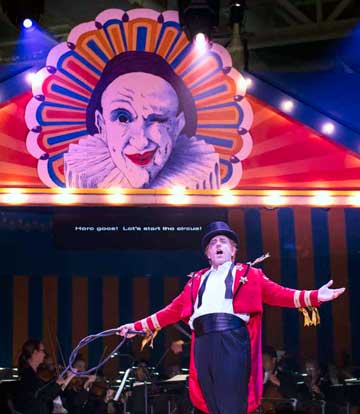Opera (1892)
Music and libretto by Ruggero Leoncavallo
Conductor: David Angus
Boston Lyric Opera
Steriti Memorial Rink
North End, Boston
September 27 – October 6, 2019
Stage Director: David Lefkowich; Set Designer: Julia Nouin-Merat; Costume Designer: Charles Neumann; Chorus master: Brett Hodgdon
With Michael Mayes (Tonio), Rafael Rojas (Canio), Omar Najmi (Beppe), Lauren Michelle (Nedda), Tobias Greenhalgh (Silvio)

Photo: Lisa Voll
Courtesy of Boston Lyric Opera
There’s a lot of plot in a short time here. Members of a commedia del arte troupe have a lot of internal struggles. Nedda (Lauren Michelle), the leading actress, is married to Canio (Rafael Rojas) but is secretly in love with a local townsman named Silvio (Tobias Greenhalgh). Meanwhile, Tonio (Michael Mayes), a sad and deformed clown in the troupe, is in love with Nedda who ridicules and spurns him. Tonio is none too pleased about that and doesn’t help matters when Nedda seeks to run away with Silvio. Meanwhile, the troupe puts on a play within the opera that trots out a lot of the struggles. Eventually, borderlines between play and reality blur and passions erupt.
This opera-event staged at the Steriti Memorial Rink in the North End of Boston is more like a festival than a straight opera. A commedia del arte room filled with acrobats, musicians and various and sundry other entertainments greets the audience for a half hour before it enters the arena for the opera proper. It sets the tone for the whole occasion which is festive, lively, celebratory and more focused specifically on spectacle than on music.
That’s okay. The BLO does a fine job with almost whatever it takes in hand, and this production is entertaining on its own terms. But what makes it distinctive is its staging.
A small round stage sits before the larger area behind which houses the orchestra. The various enactments of the plot take place on that small stage while, at various points, chorus, acrobats, and other personnel filter down the aisles of the audience. The effect, sometimes, is completely captivating. I found it particularly nice to have chorus members singing energetically from the aisle next to me, and hearing them up close I was seriously impressed by their musicianship.
Were the acoustics of the rink good enough to amplify the main voices onstage, I might have felt more appreciation for them, but they, in addition to the orchestra behind them, seemed somewhat muffled. Though Lauren Michelle as Nedda did belt it out at times as did Rafael Rojas as Canio, the general effect was somewhat muted. But, after all, this is a hockey rink, and though draped and clothed to enable an opera, it still has its limits.
The production did go all the way to dress up the rink, however, and the results were visually impressive. Overall, the spectacle part of the production wins high marks. Chorus members, some in plainclothes and some in commedia del arte garb, filtered in and around the audience and the effect was transfixing.
The opera is presented mostly in English, which, in this case, did not quite hit a chord on this end. Vesti la giubba in English is just not the same. I appreciate the effort to make the opera more accessible, but, after all, there are pretty readable supertitles and it seems like that would be enough to do the trick.
Last spring’s production of The Handmaid’s Tale at the Harvard basketball arena, though also framed in an athletic facility, seemed to work better somehow. Perhaps it has to do with the dystopian theme of that opera. But, as well, in that case, it seemed like the more open design of the space made it more accessible; there, the orchestra was behind the action but was not squashed within containing curtains as it was in this one.
– BADMan (aka Charles Munitz)
Leave a Reply